Baby Bearded Dragons are a great way for first time reptile keepers to have a pet dragon.
Do not let the name ‘dragon’ scare you!
These lizards are tame, docile and easy to care for.
Babies are born a tiny three inches long and only grow 16 to 24 inches in length.
A Baby Bearded Dragon can be purchased for just $100. But before bringing a baby Beardie home, you will need to know how to care for him.
Here are eight tips you need to know before getting a Baby Bearded Dragon…
1. What To Know Before Buying A Baby Bearded Dragon
It is both good and bad that Bearded Dragons are a popular pet lizard.
To find a Baby Bearded Dragon for sale is very easy. This also means it is easy to find a species that is illegal or unhealthy.
Importing wild Baby Beardies from their native range is illegal. Do not purchase a bearded dragon labeled as wild-caught.
Purchase a captive-bred lizard from a reputable private breeder.
You will want to purchase a lizard that looks happy and healthy:
Signs They Are Healthy
- Their eyes and skin are bright.
- Standing up with all four legs.
- Good posture and active in their enclosure.
- Reactive to your touch.
Sickness Symptoms
- Swollen hind legs or rubbery jaw.
- They should be active and not lethargic.
- Runny or watery stool.
Make sure you do the research to find a reputable breeder.
Baby Bearded Dragon Price
Baby Bearded dragons can be purchased for $45 to $100.
Species that are not tan brown (e.g. color morphs) are more expensive and cost $100 to $750.
The initial setup cost of their enclosure will be $200 to $1,100. This includes purchasing a 20-gallon juvenile terrarium, lights, substrate, hides and food.
There are starter kits available for Bearded Dragons that cost around $200. But, they do not always include the proper supplies.
2. Best Baby Bearded Dragon Habitat
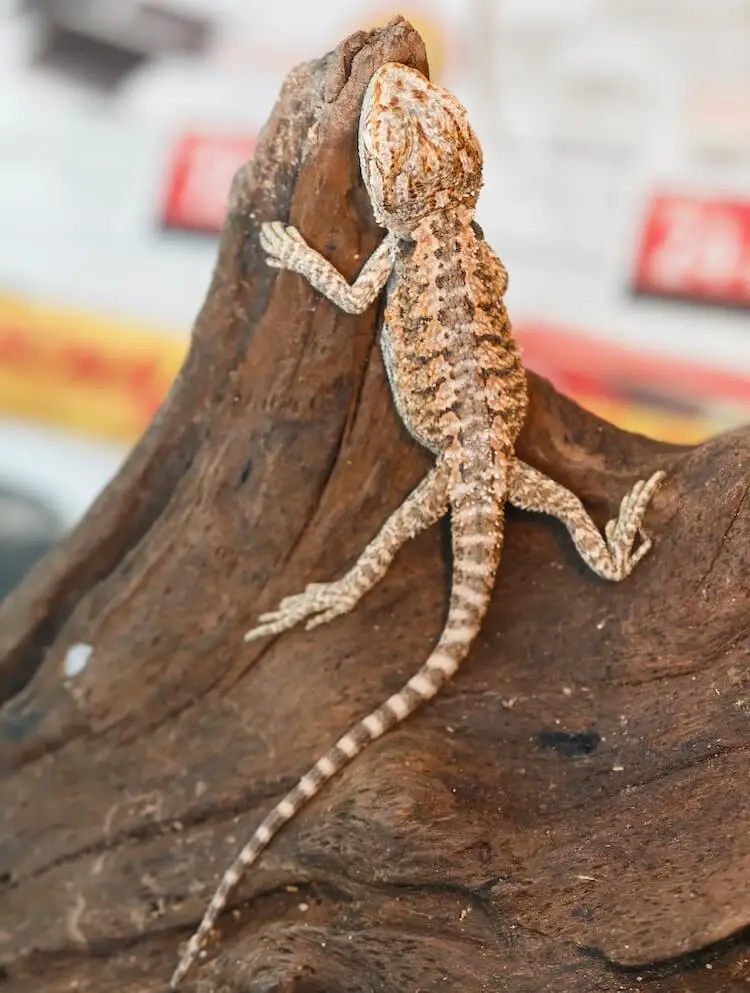
A baby bearded dragon first needs a 20-gallon tank. As they grow their tank size should too.
Fully-grown adults require a 120-gallon tank.
Because they grow so quickly some owners purchase an adult cage to start with. That way they do not have to buy multiple enclosures:
| Age | Minimum Tank Size |
|---|---|
| 1 month | 20-gallon |
| 2 month | 30-gallon |
| 3 – 6 months | 50-gallon |
| 7 – 9 months | 75-gallon |
| 12+ months | 120-gallon |
Baby Bearded Dragon Lighting
Bearded dragons should get 12 hours of light daily – babies too.
To achieve this Beardies need both UVA and UVB lights in their habitat:
- A UVB light tube (not coil) should on for 12 hours a day from 7AM to 7PM. The easiest way to do this is to buy a light timer.
- A 50-75 watt UVA bulb should be used inside of a dome light fixture. This light can sit on top of the screen lid or can also hang inside the terrarium.
It is important to get a UVB light that is tube shaped and not coiled. Your UVA bulbs should be dome shaped so that your dragon can properly bask.
Baby Bearded Dragon Heat and Basking Temperature
Their cage will need a temperature gradient. This allows your dragon to move in and out of the basking spot.
Your baby bearded dragon’s basking area should be between 95 to 105℉ degrees. The designated basking area will be the hottest area in the tank. It should be on the left or right side of the tank.
If your UVA bulb is setup properly the cold side of the cage should be around 75℉ degrees.
It is important to buy two high quality thermometers for either side of the tank. You need to make sure your baby lizard has the correct heat levels.
If temperatures are too low during the night (below 65℉) you can add a ceramic heat emitter.
Baby Bearded Dragon Humidity
Your dragon’s enclosure should be between 30% to 40% humidity. If the enclosure is too humid your lizard can become sick. If it is too dry they will dehydrate.
Make sure to invest in a high-quality hygrometer to measure water vapor levels.
The best way to achieve proper humidity is to include a water dish in their tank and allow the water to evaporate.
A water dish must be shallow enough for baby bearded dragons to enter and exit by themselves. The water should not be filled more than their chin-level. For babies this might be just one cm.
Baby Bearded Dragon Substrate
Substrate can be a confusing topic for new owners.
One mistake many bearded dragon owners make is using reptile sand in their enclosure. Despite Bearded Dragons living in sand in the wild your dragon should not be kept on sand.
Commercial reptile sand is different from sand in their natural habitat.
If your lizard is kept on sand – it will get in their eyes, their water and food. If a baby consumes too much sand its intestines will be blocked causing impaction.
The best substrate for a bearded dragon is reptile carpet.
If you cannot find reptile carpet there are a few options you can choose from:
- Newspaper.
- Paper towels.
- Non-adhesive shelf liner.
3. Baby Bearded Dragon Setup Tips
- Secure 20-gallon terrarium with screen lid.
- UVB light tube (not coil) turned on for 12 hours a day.
- 50-75 watt UVA bulb inside of a dome light fixture.
- Basking area should be between 95 to 105℉ degrees
- 30 to 40% humidity.
- Reptile carpet – not sand or wood shavings.
4. Baby Bearded Dragon Diet
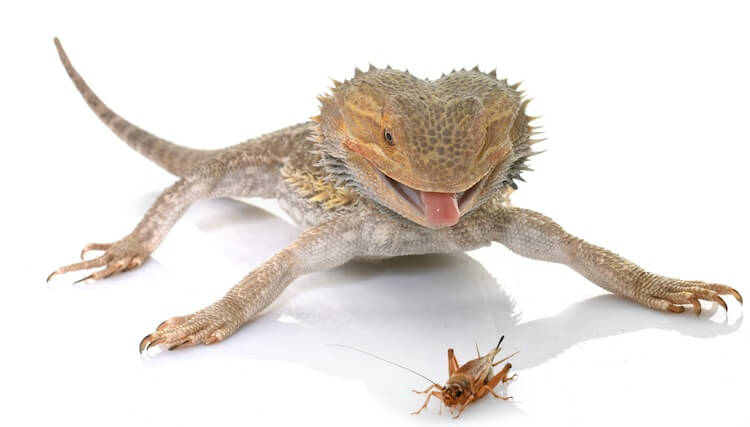
Baby and juvenile Bearded Dragons eat mostly insects in the wild.
As they age their diet changes to mostly vegetarian.
This means your baby bearded dragon will have a different diet compared to an adult:
- Babies should be fed a ratio of protein to greens of 75/25.
- Adults should be fed a ratio of protein to greens of 25/75.
What Does A Baby Bearded Dragons Eat?
They should eat small Dubia roaches or 2-3 times a day. They are better than mealworms, as it is hard for babies to digest mealworms.
Babies should be fed a balance of crickets and plants to maintain their health. A ratio of 75% protein to 25% greens is nutritionally best.
Some vegetables you can feed include:
- Collard Greens
- Dandelions
- Mustard GreensBeet Tops
- Other Leafy Greens
- Beet Tops
- Leafy Greens
- Carrots
- Squash
- Peas
- Zucchini
Low nutrient foods such as lettuce, spinach or celery should be avoided.
If you want to give them a treat you can offer small fruits such as blueberries or peach slices.
How Many Crickets To Feed A Baby Bearded Dragon?
Babies should eat 20 to 40 small crickets each day.
Special care must be taken to ensure hatchlings get the right food for their size. The crickets you feed should not be larger than the distance between your dragon’s eyes.
It is best to let your lizard eat as many crickets as they can in a 10 minute window. Normally they will eat a cricket every minute or so.
After 10 minutes remove any excess food from the cage. Do not leave any insects in your dragon’s enclosure as they can hurt your pet.
Here is an example feeding schedule for a baby or juvenile:
| Time | Insects | Greens* (all chopped**) |
|---|---|---|
| 9 AM | 10+ small crickets | 2x collard greens, 1x bell pepper slice and 1x strawberry |
| 12 PM | 10 + dubia roaches | 2x kale, 1 slice of squash and 1x blueberry |
| 3 PM | 10 + small crickets | 2x dandelion greens, 1 slice of pumpkin and 1 slice of banana |
| 6 PM | 10+ dubia roaches | 2x collard greens, 1 bell pepper slice and 1x grape |
* To promote healthy growth you should dust their food with calcium a few times each week.
** Make sure that all food is cut into small pieces to prevent choking and indigestion.
5. Track Their Growth Rate
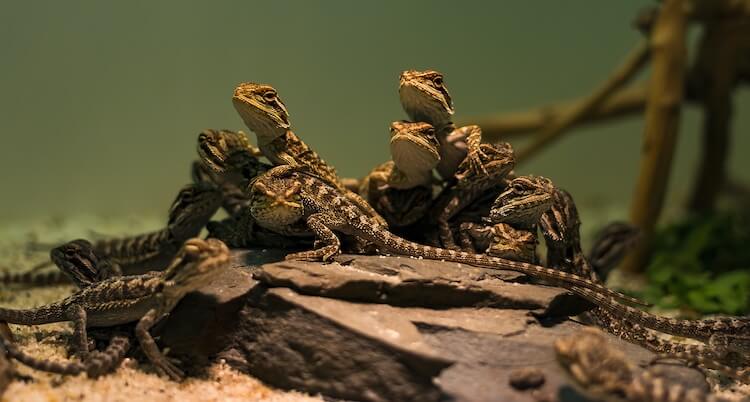
Baby Bearded Dragons are born three to four inches in length.
Healthy hatchlings grow 1 to 3″ per month for their first two months.
It will take 18 to 24 months for your dragon to reach its full grown size.
Females are smaller than males and range from 12 to 20 inches in length. Males are 16 to 24 inches.
Beardies grow quickly when cared for properly.
You should be very observant of your baby lizard’s growth for the first 12 months:
| Age (months) | Size (inches) | Weight (grams) |
|---|---|---|
| 1 month | 3 to 4 inches | 4 to 6 grams |
| 2 months | 5 to 9 inches | 8 to 40 grams |
| 3 months | 8 to 11 inches | 22 to 110 grams |
| 4 months | 9 to 12 inches | 41 to 115 grams |
| 5 months | 11 to 16 inches | 102 to 115 grams |
| 6 months | 11 to 18 inches | 183 to 188 grams |
| 7 months | 13 to 18 inches | 230 to 280 grams |
| 8 months | 14 to 20 inches | 252 to 327 grams |
| 9 to 10 months | 16 to 22 inches | 280 to 360 grams |
| 11 to 12 months | 16 to 24 inches | 350 to 465 grams |
If your lizard is not growing or eating then there could be a health problem.
Metabolic Bone Disease is a common issue with pet lizards. This disease causes problems with bone health and growth and in some cases causes death. It is a bone disease caused by improper nutrition (often a calcium deficiency) or improper UVB lighting.
6. Baby Bearded Dragon Care Sheet
The normal lifespan of a bearded dragon is 7 to 12 years.
Metabolic bone disease, respiratory infections and abnormal shedding (i.e. dysecdysis) are all common, but potentially fatal, health issues for beardies of any age.
Proper care is vital to ensure your lizard lives a long and happy life.
Use the care sheet below as a quick guide to make sure their cage is setup correctly and their diet is proper:
| Baby Bearded Dragon Care Sheet |
|---|
|
7. How To Tame A Baby Bearded Dragon
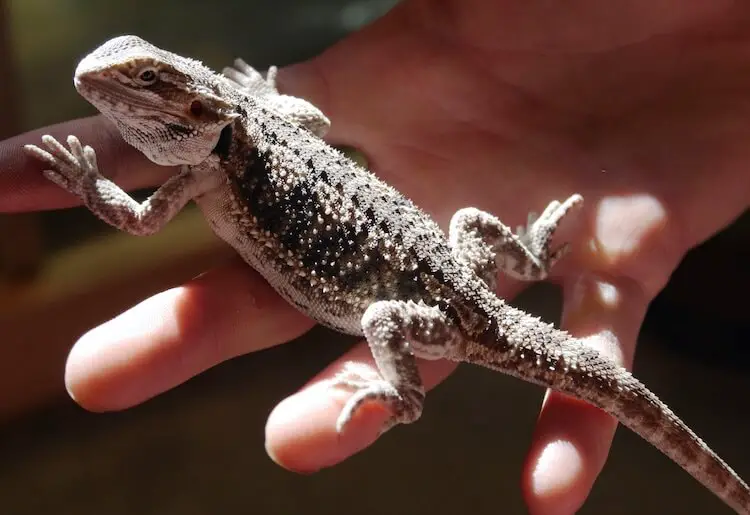
Before handling your baby dragon you should wait at least a week.
Babies are more skittish than adults.
Baby Bearded Dragons are also small and should be held with extreme care.
Once your lizard is eating regularly you can begin to tame him:
- To start with offer your hand and coax him gently.
- Without making any sudden movements hold him underneath his belly and support his weight.
- Do not grab him from above or by the tail.
If you care for your lizard and handle them properly you can expect them to be very relaxed and happy being held. Their docile nature is a large part of why they are a popular pet lizard. But, they need proper and gentle handling to get them used to your touch.
8. Know What To Expect
There are several things you should expect when adopting this species.
To start with you should be prepared to have him for around 7 – 12 years.
Doing your research before buying a baby bearded dragon is very important. So is purchasing from a private breeder.
It is always better to purchase an enclosure and get it setup first. Doing this will make the transfer of your Beardie much easier. You will also have temperature and humidity under control.
Unless you have your lights plugged into a timer (which is highly recommended) you will need to turn the lights on in the morning and off in the evening every day.
You will need to feed him three or four times each day at 9 AM, 12 PM, 3 PM and 6 PM.
Do not expect babies to be completely comfortable around you at first. They will need time to adjust to their new surroundings.
They may also not want to eat immediately after coming home. If their husbandry is correct they will be ready to eat after a day.
Summary
Caring for a Baby Bearded Dragon is simple for beginners.
To start with they will need a secure 20-gallon terrarium with a screen lid.
Two of the most important things to remember are their habitat and diet:
- Feed 20 to 40 crickets a day over three or four 10 minute periods.
- Keep their basking area 95 to 105℉ degrees and make sure humidity is 30 to 40% humidity.
If you do your research, and take care of your beardie, you should expect them to be very tame and live for 7 – 12 years.
Let us know how you cared for your Baby Bearded Dragon below.

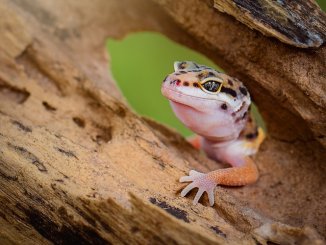
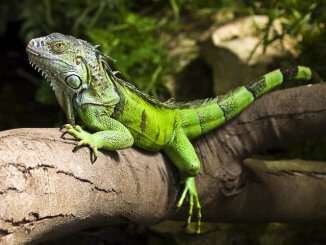
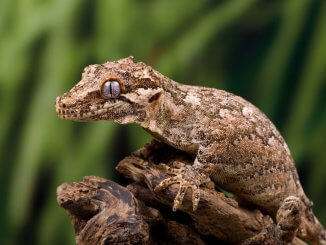

I appreciate all your information. I own a beardie owner and want to take care of him the best possible way!
I’m pretty sure it’s illegal to own a beardie owner
Had my bearded dragon couple days now not eating alot but concerned wondering if it just needs time to adjust to hiss new surroundings or is it sumthing I should worry about
Do I leave the uva lamp on 24/7?
No, just during the 12 hour daylight period
Do I need to dust all the crickets with calcium or just 3x a week.
Only twice or three times a week. You do not want to give too many supplements. To ensure your dragon has some control over its calcium intake, you can put a sepia bone inside the enclosure, which act as an insurance against calcium deficiency.
Hi my grandson just got his first baby or juvenile bearded dragon four hours ago we’re trying to set up his aquarium now we have a I hated that goes on a bottom of the aquarium the flat heater question is do we leave that on 24/7 and do we use the big lamp and what bulb do we put in the big lamp at night do we keep water in there 24/7 and what kind of light do we put in there at night do we use the compact fluorescent bulb light 13 watt or do we use the black night light bulb 13 watt or do we leave daylight bulb 75 want or do we use the basketball or the infrared basking thought bulb 75-watt please help me with this
This will be an awesome adventure for your grandson, but make sure you set up the perfect enclosure for the animal.
A heating pad is an important feature for a bearded dragon tank, especially in the colder months of the year, but make sure there is some thickness between the pad and the dragon’s belly. Keep in mind you should maintain a warmer ‘basking’ area of the tank, which should provide the dragon a warm area reproducing the daytime conditions of its habitat: 95-100°F for 12-14 hours a day should be perfect. The colder part of the tank, serves to cool down and should be around 83-85°F. At night, turn off any light source, but as the temperature approaches 70°F you might want to leave the heater pad on, since lower temperatures can cause your dragon to get too cold and even go into brumation.
In other words, light and warmth should be provided during daytime (infrared light, UVB light and heater pad are your climate control options), while in the night you could theoretically turn everything off as long as temperatures do not drop below 70°F. Similarly, water can be kept in there all the time, as long as its evaporation doesn’t increase humidity above 40%.